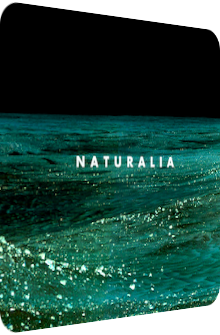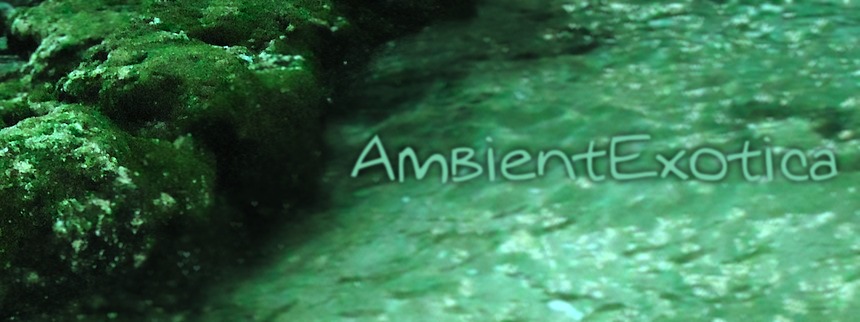
Oliwa
Naturalia
2013
Sÿnthorama! At the time of writing this review, I am, according to a quick Google search, currently the only one who ecstatically uses this poorly constructed blending in written form (with the letter ÿ) whenever I come across largely or even purely synthesizer-fueled soundworks. I am probably one of the more devoted advocates or sticklers of such works, for the arpeggiophile Ambientscape changed over the decades, from its positively idiosyncratic beginnings in the Synth Pop-heavy 80's over the so-called IDM and Glitch fleeting visits in the 90's to the post-millennial, purposefully camouflaged endeavors in terms of the Drone genre with its guitar strings. Purified synth albums are seen as retrogressive nowadays, but much to my joy there are artists who fathom out the endless boundaries of electronic Ambient music to this day, evoking cyberspace sceneries, a digitally lit metropolis or luminescent jungles. I usually link the bubbling, sometimes beat-accentuated works of Stellar OM Source, Panabrite and Zoë Blade to these vintage outlooks. It so happens that Buenos Aires-born Sebastian "Sebi" Oliwa is another artist who resides in these exciting music-related climes. His latest CD Naturalia comes in a strictly limited edition of 50 copies with one laser-engraved button per album, is released on Gavin Catling's Perth-based Twice Removed label and available to purchase and listen to in full at Bandcamp. The digital-only version of the release is currently set as "name your price." The six tracks off Naturalia connect the previous dots and moods of Oliwa's casette Rituals, released on the Swedish Zeon Light Kassett label in mid-2012. Naturalia's backgrounds, however, are much darker in order to let the neon translucency of the spacey synths calcine even more blazingly. Its strongly aquatic color range as depicted on the front artwork is found throughout the roughly 30 minutes of its runtime. Are these green meadows or lost oceans? A closer look reveals these mountainous shapes to be ocean waves, but the colors, the pointillistic whitecaps and the pitch-black background are deliberately ambiguous. One could tell the story of Oliwa's album quite shortly: Naturalia uses a maximum of arpeggiated and legato Synth Pop hooks of the 80’s, with all of them being played at once, constantly interfering and overlapping with the unfolding ambience. AmbientExotica is not about short stories though, but a deeper look at things. And eureka, there are strange mysteries aplenty, lots of conflicts and ongoing clashes rout the sounds, euphonious sections are flee(t)ing, exchanged with darker chords, then rising again in a different shape. Read more about both this cleavage and the fascinating interplay below.
The eponymous Naturalia functions as the initial gateway to Sebastian Oliwa’s bifid synth structure awash with twilight. He creates a dualistic mélange of forlorn outbacks and a distantly glistening hazardous heat akin to Triola’s stern transformations of melancholia. Even the textures are similar to Jörg Burger’s Triola pet project on Kompakt Records. The base frame comprises of a diffusely guitar-resembling creek and majestic bass drones. These rhizomatic strata are the figurative grass roots and cause images of vigorous verdure or rich green pastures. The remaining layers are in steady conjunction with this lush prospect, but of an adamantly contrapuntal structure: The oscillating loops, blurry scintillae and star dust-coated undulations induce an aura of aloofness and amicability, their spacey traits and warped flecks orbit around serpentines wadded in haze, a bass propulsion at the right moment augments their impetus, while in other instances incidental echoey footsteps and clangs inject a sense of plasticity and wideness. It then turns out that these footsteps are part of a percussion scheme, and so Naturalia shifts its shape again, this time less forcefully so, and provides a short moment of pulsation, progress and stride before it fades out with the implied prurience of female chants. Right from the get-go, Naturalia hits the listener with its open fields and profound layers. It is hard to pinpoint the specific mood. What is Oliwa’s trick? For one, this is no classic Drone track, but a cyberspace-spawning post-Detroit anthem sans beats. This fact alone is not particularly surprising. It is, secondly, the ever-changing timbre, the mirage of tones in major and minor, the conflicting shimmers and their dispersal that make this title track so catchy. It is torn between earth and space. And won’t remain the only dichotomous artifact as Eterna shows. It uses the branches and scions of the opener and lets them grow in the opposite direction. Oliwa travels back in time to the early 80’s. Chopped-up acid rotors float above a misty decoction of abyssal drones. Their solemn effervescence shows the omnipresent melodic changes much more clearly, for these rotors are the only tuneful source on this tune. Ranging from golden-shimmering euphoria over dusky precariousness to a shrouded mystique, Eterna may be beatless, but remains in a moving state. The backdrop is pitch-black, the decay of each synth stab volatilizes into the empty void.
The following Amoeba changes the physiognomy of the the album decidedly, but moulds the new demeanor with the same ingredients and finishes it off in the same color range. Amoeba is a genuine Drone track of the spectral-mollifying kind, completely entrancing and much more streamlined and silkened. A ghostly two-note melody is stretched and meanders along ever so gently, its superstructure is highly analogue: a belly-massaging base is accentuated with a turquoise-tinged melancholy, wind-like drones and micro-oscillations. Since this state is maintained for quite a long time, the listener is allowed to inspect the half tones and hatched granularity of this aorta. Soon enough, Oliwa ennobles this state, but not with counteracting particles, but fitting molecules in the forms of reverberated synth droplets and bright waves which accompany the two-note stasis and brighten it up decidedly. In its brightest, most euphonious moments, Amoeba is anything but beautiful, the synth choir-evoking streams and polylayered entanglement successfully camouflage the threnodic crevasses for the first time. I do not know how an amoeba feels or how many amoebas are needed to create a certain feeling (an epigraph akin to how many roads must a man walk down), but this tune marks the album’s pinnacle in terms of accessibility, gracefulness and benignancy. This state is almost crushed by S Is For Space if you consider its first few seconds which unleash banefully buzzing electric sparks, but even though these hazardous splinters reoccur from time to time, it is the arpeggio of the 16-bit chimes in tandem with the chirping of the cyberbirds that lessen the bile and interpolate the impression of a spiraling waterscape (despite the birds). The chimes and square lead pads throb and swirl in a playful way, but Oliwa’s tendency of interlacing a certain mood so that it does not become easily interpretable is also used in this arrangement. Quirkiness, loneliness and pulchritude coalesce.
The final duo of compositions is a real treat for Ambient fans who want their airwaves filled with glissandos and ubiquitous runlets of oozing synths rather than the spluttering kinds. Passionaria has an auspicious title, and indeed, everything it promises in its eleven letters is fulfilled in the soundscape itself. The Argentinian synth wizard changes the virtual surface of his object once again. Heretofore, the warmth or copiousness of a texture was reached via multiplicity and intertwining; several melodies and the fundament of a bass drone usually resulted in either densely coated auras or chasm-streaked fissure-laden locations, even though the layers themselves were rather thin when played in isolation. Passionaria rectifies this situation. It may launch with distant gales and dark matter pads, thus creating a murkily bubbling ambience, but soon enough a foggy synth string appears. Its opalescence ranges between frostiness and orange tinges of friendliness, and though it glows strongly, it does not outshine or destroy the carefully balanced subsidiary locations. Glistening drones of vagueness and the delicate vinyl-like crackles unite, even the darker synths get whitewashed and appear in a gentler form. The dreamlike state of tentativeness is skillfully transcoded into sound, Passionaria is infinitesimally wailing, but otherwise floats along, again escaping from any prerogative of interpretation. The outro Shockwave seemingly presents every layer that was present up to this point… and maximizes the hell out of it. The voluminosity and grandiloquence are breathtaking, every mood is increased at least threefold. The synths gleam and coruscate, changing melodies are played on one echoey crystalline synth which warps their tones to outer space, warm cascades rise and grow, everything is delicately artificial, various states of plinking and growing take place until a long fade-out phase revs up the coldness until darkness resides again. Due to the wealth, harmony and the vigorousness of each layer, it is easy to fall in love with Shockwave and its many colorful subjections. It is the culmination point of every major and minor detail, vesicle and atom of the album and therefore a terrific closer.
Naturalia erects the prospect of being in close touch with nature. This is decidedly not the case, for everything is alienated and covered in a cyan hue. The album encapsulates the listener, never guides him or her through the rivulets or floods of burgeoning moisture. There is no overarching guideline as how to approach a certain section, at least not in the wallowing, fizzy tracks where a clear-cut motif is as amiss as a repetitive structure. In a poignant way, this seemingly improvised setting could be described as organic, but strangely enough, this description is not apt, and the reason leads to the textures which are often grim, enigmatic and otherworldly on the one hand, and then clash with balmy, mollifying and liquedous waters on the other. Never is the liquid lentic. It rather floats, moves, rises and falls without the permanent occurrence of blebs or bubbles. Likewise, there are no field recordings used, the only chirping birds which appear are synthetic droplets that coincidentally resemble these creatures' pitch. Sebastian Oliwa's actual achievement leads to the incessant amount of changing tone sequences and gyrating timbres, one can never be sure of Naturalia’s next phase, not even in the utterly dreamy vault-like tracks like Amoeba. As much as the listener is embraced by Naturalia, he or she is also pushed away. There is hardly a moment of gleeful eruption, nor are the acidic cylon flecks all too contemptuous. Naturalia is an exciting ride, and once it ends with the saturated fanfare Shockwave, one is left alone pondering. Are the 80's spirits of this work harmonious and good-natured in the end? Is there a perfect balance between sound, sustain and space? And what came first: the front artwork or the music? As every terrific multilayered cyber-oid beatless post-Rave album shows, answers about tonal range, timbre and atmosphere are impossible to pinpoint. I know that I have a great work in front of me when I lack the skills to dissect it while being lured by its sound layers. Kudos to Sebastian Oliwa's sÿnthorama!
Further listening:
You can purchase ( currently "name your price") and listen to Oliwa's Naturalia at Bandcamp.
Ambient Review 197: Oliwa – Naturalia (2013). Originally published on Mar. 27, 2013 at AmbientExotica.com.
